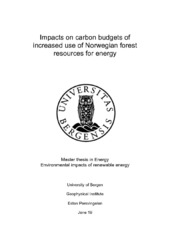| dc.description.abstract | When forests are logged for heat and electricity production, emissions from burning of the biomass are not accounted for in national greenhouse gas reporting to the climate convention. This would have been correct if a forest stand did immediately regrow to its initial state, storing the same amount carbon as was logged. In reality, a carbon debt is created after harvest and lasts until a replanted forest stand has grown and absorbed as much carbon as the old one stored. By increasing the harvest rate, logging younger trees in rotational forestry, there is a loss of stored carbon in the forest. This carbon debt could be partly or fully repaid, using the harvested wood. E.g. bioenergy from harvested wood can replace an equivalent amount of fossil energy, and thus avoid the corresponding greenhouse gas emissions from the fossil energy source. This thesis aims to quantify the temporal imbalance between carbon losses and gains of a permanently increased harvest, using a simplified model of Norwegian forests capturing some of their characteristics. An uneven-aged forest of a constant area is studied, where a share of the biomass is removed by harvest, and a share is left on site decaying. Future harvest conditions which are considered the most realistic and viable give a carbon payback period ranging from 89 to 362 years. This range comes mostly from estimating how much greenhouse gas emissions from fossil fuels that is avoided by replacing it with bioenergy from harvested wood. Using a medium estimate from the literature results in a carbon payback period ranging from 89 to 123 years. The sensitivity of the carbon debt to using additional trunks and harvest residues is tested and included in these estimates. When a portion of the additional trunks is used in constructions, the carbon payback period is shortened by 1 to 23 years for the chosen forest characteristics depending on harvest condition. Carbon debts from only utilization of existing harvest residues for bioenergy could most probably be repaid within 24 to 86 years. A brief introduction to global forests and a literature review of national forest dynamics has also been performed to put the study in context and select parameters for modelling. The present state of Norwegian forests is shown to be strongly conditioned by forestry practice the last 100 years. Dynamics not included in the model is discussed, and in what direction related processes probably would influence the results. | en_US |
